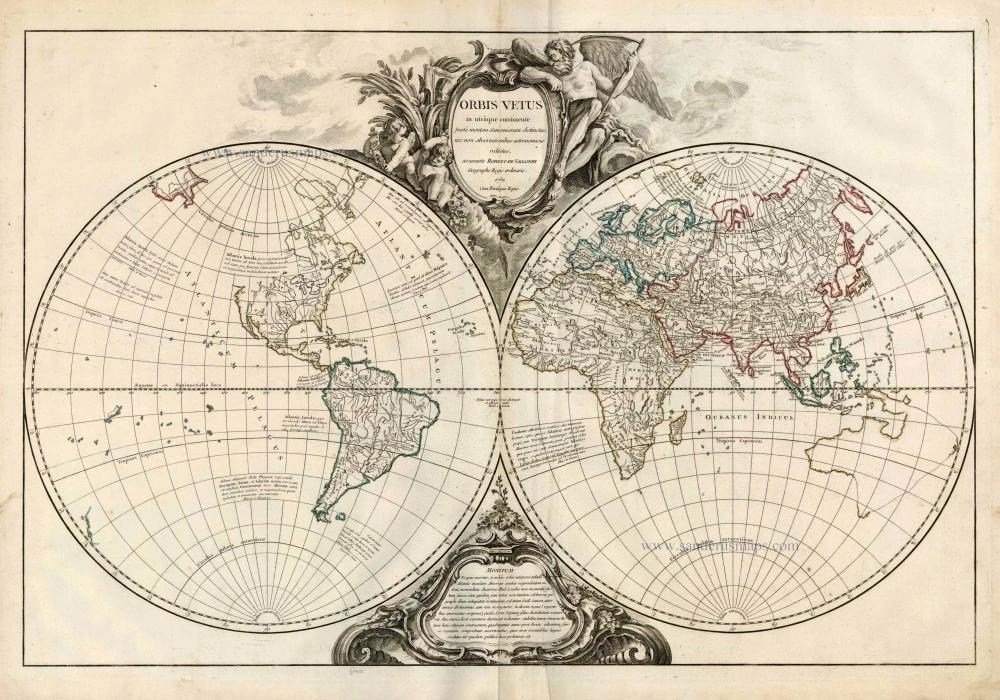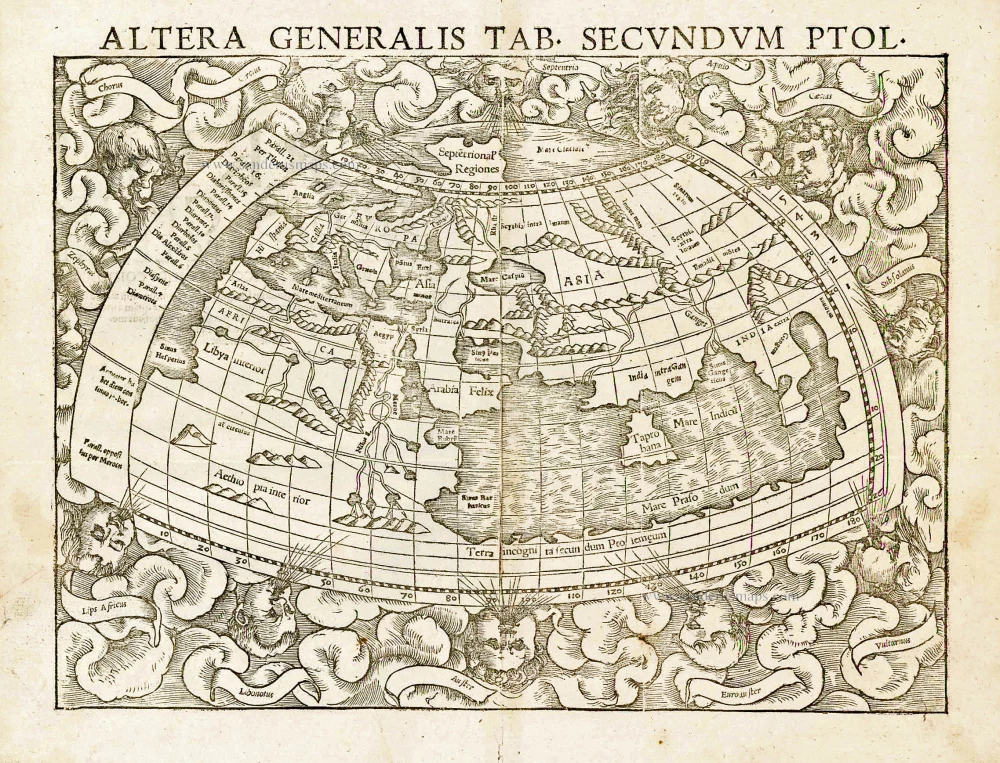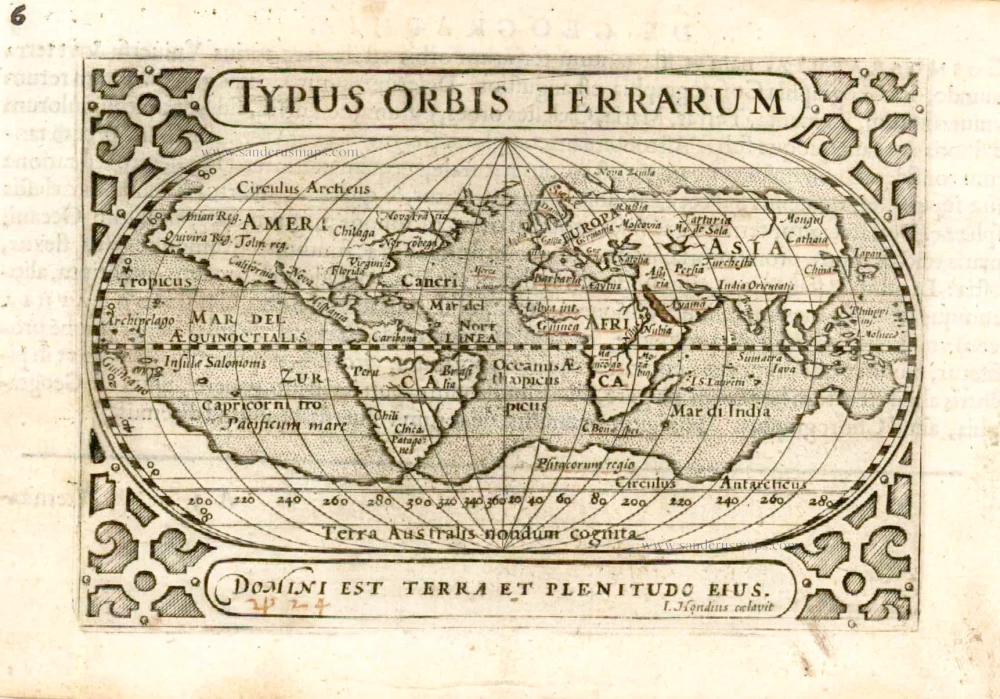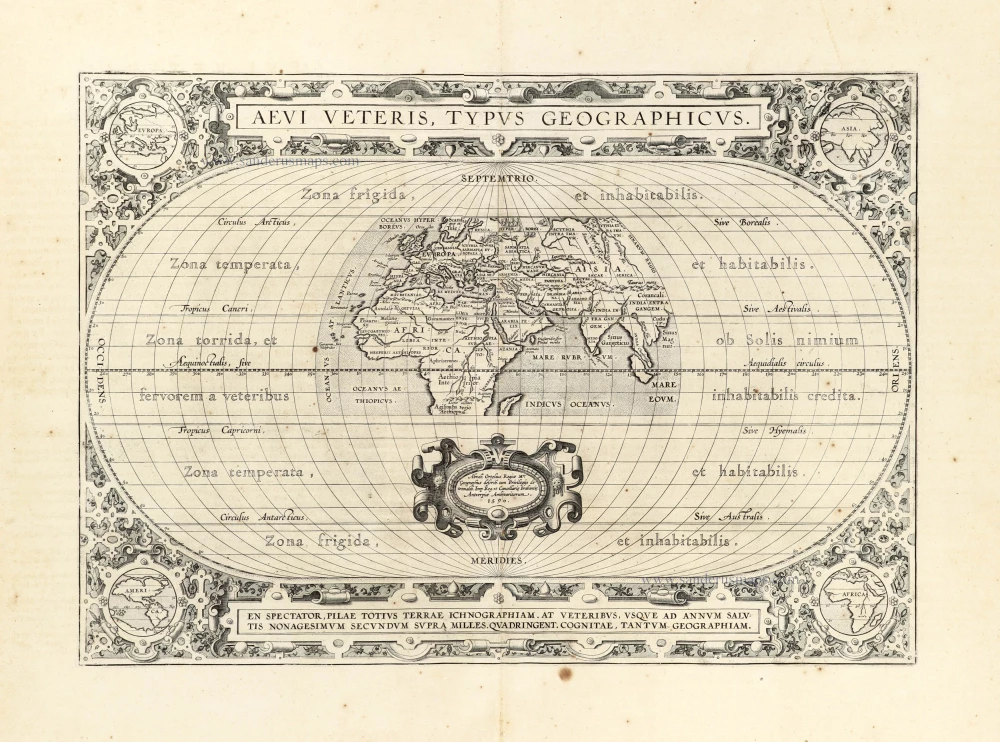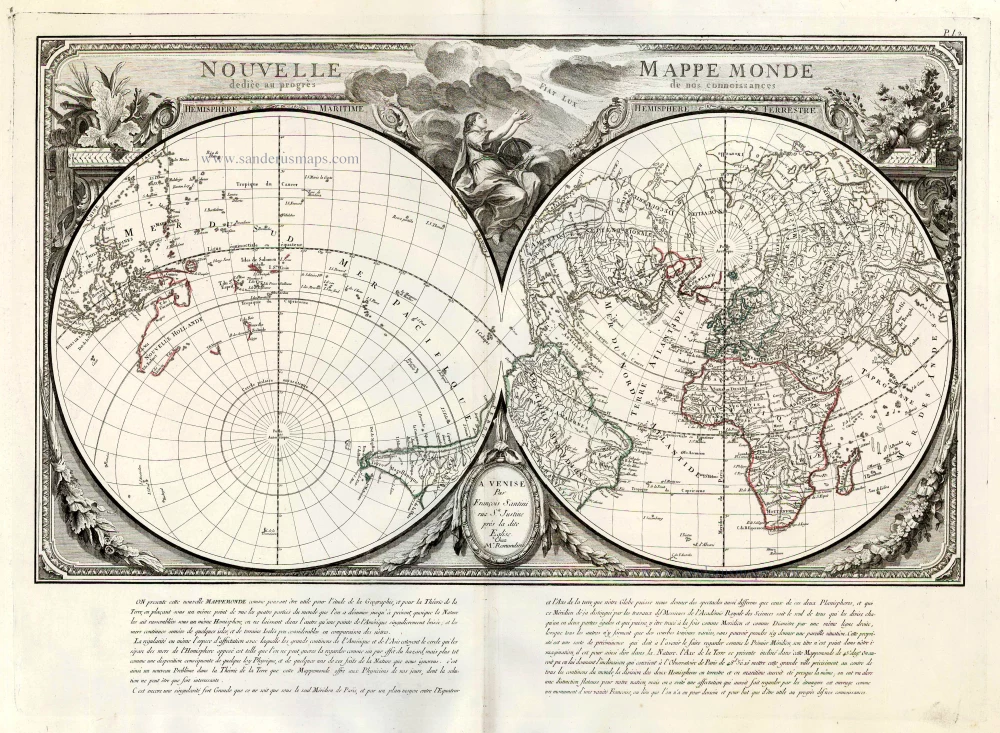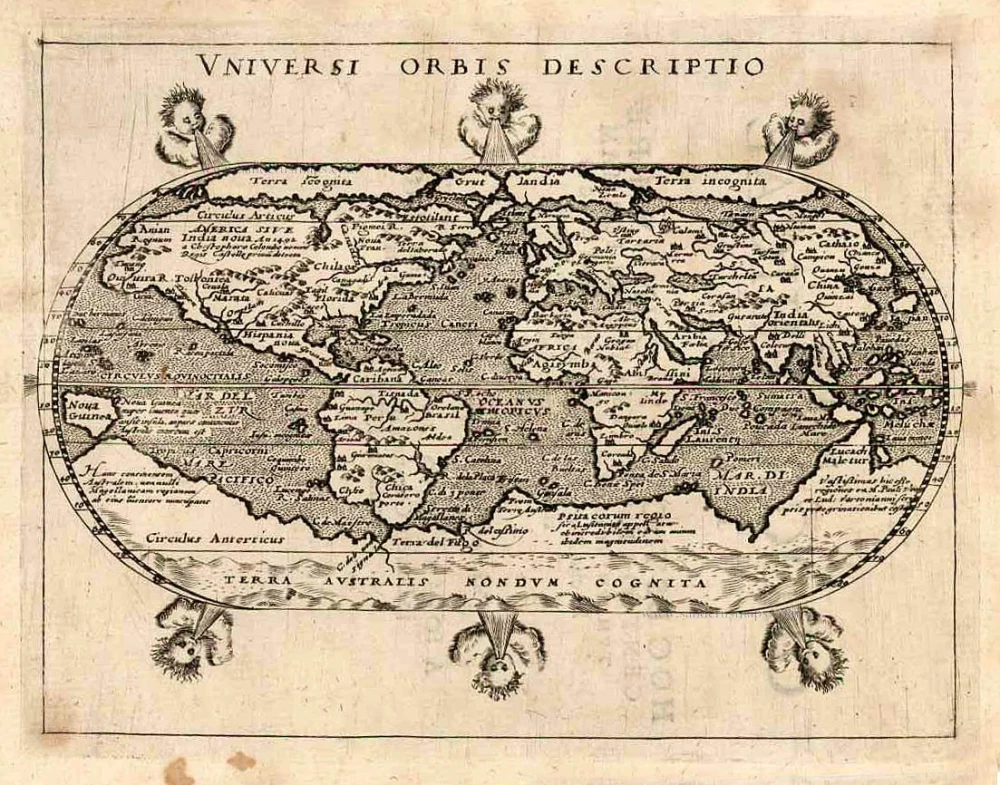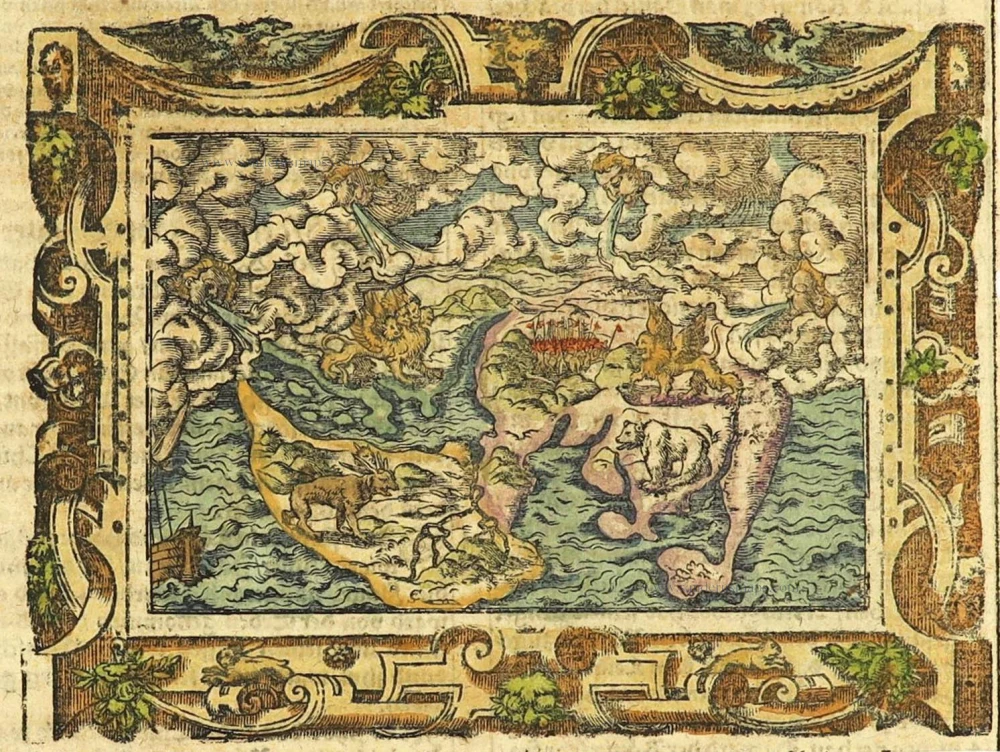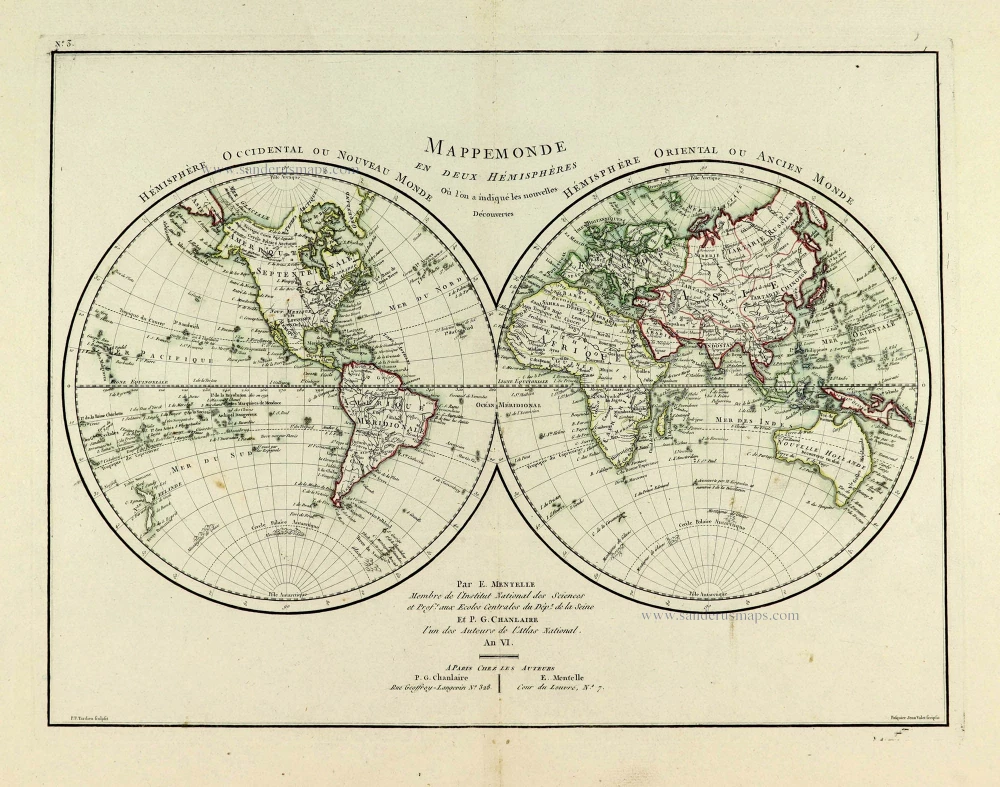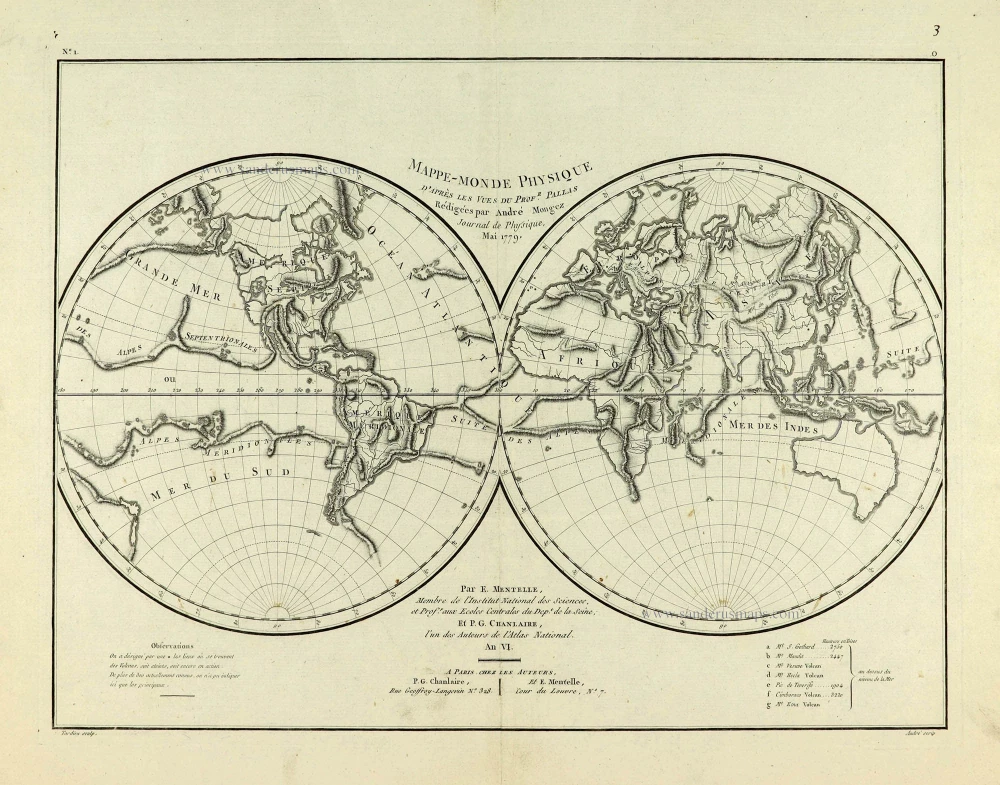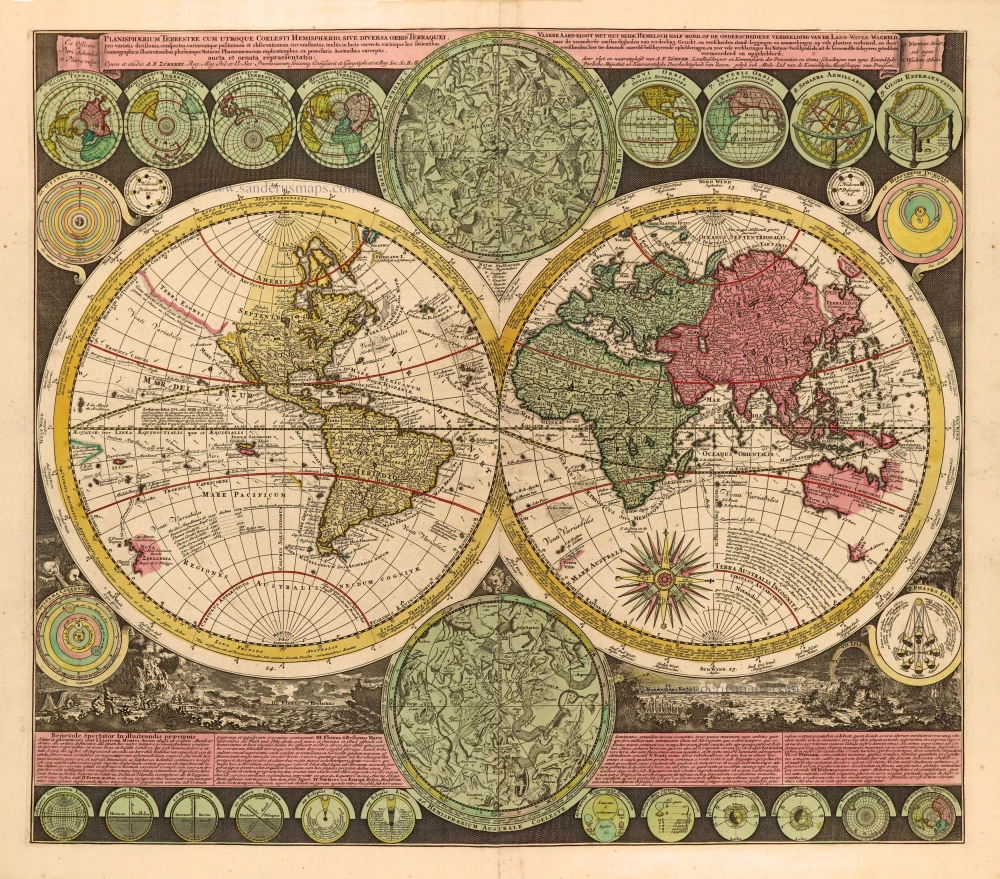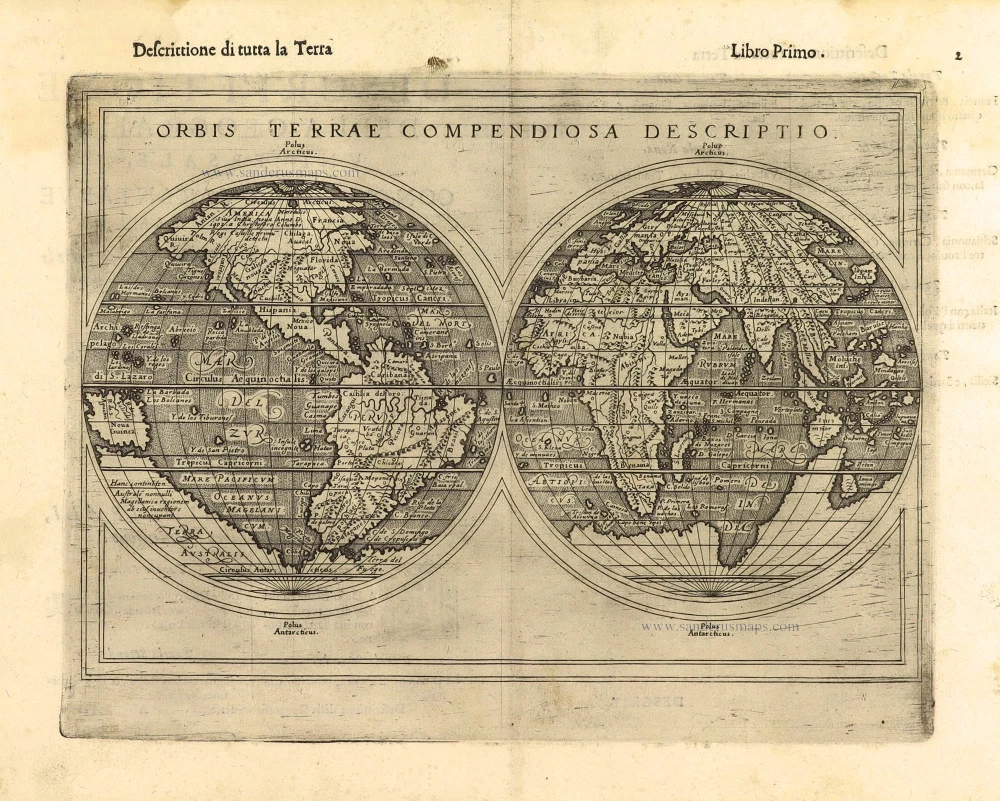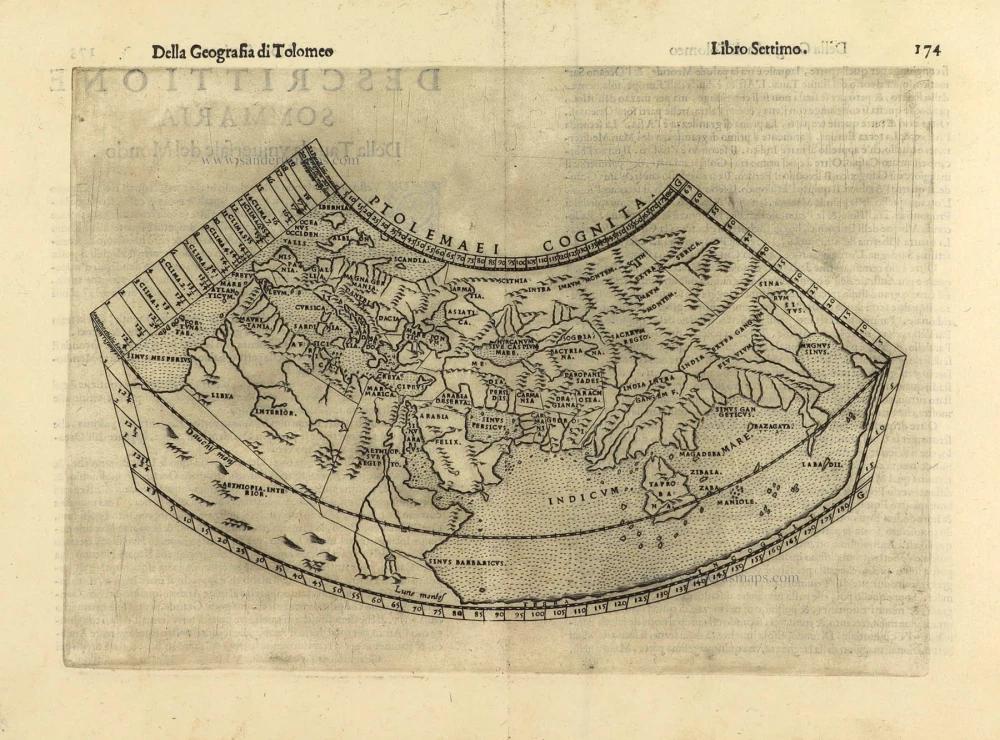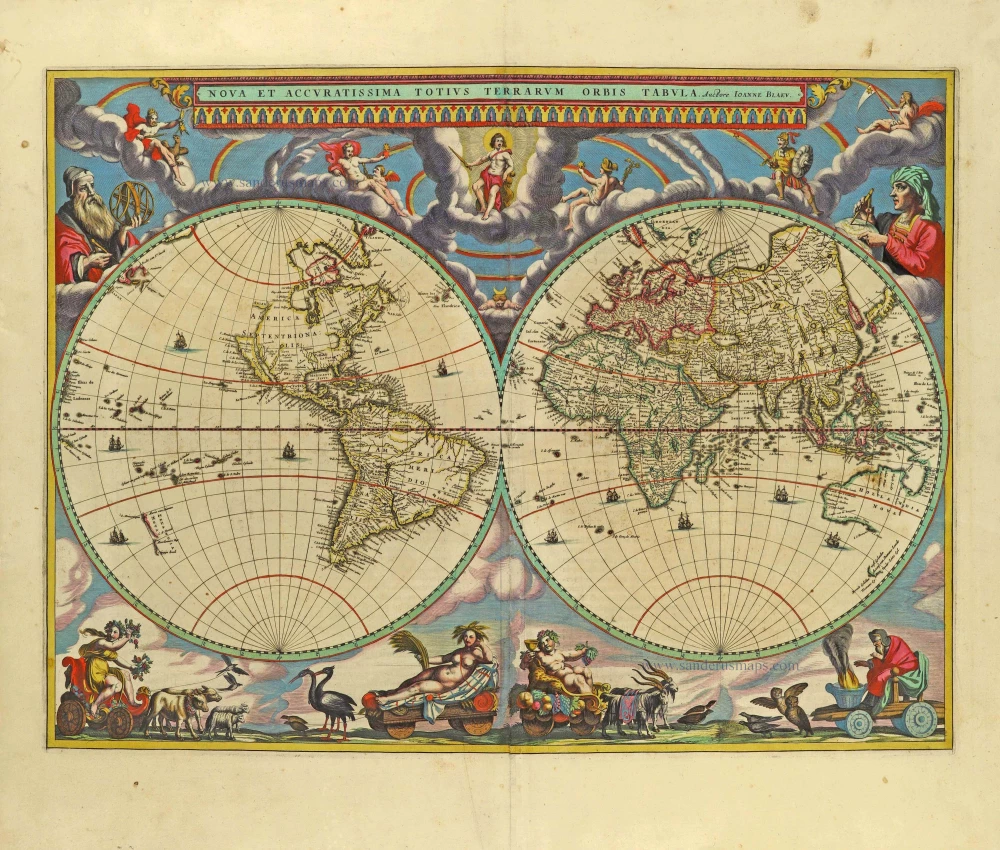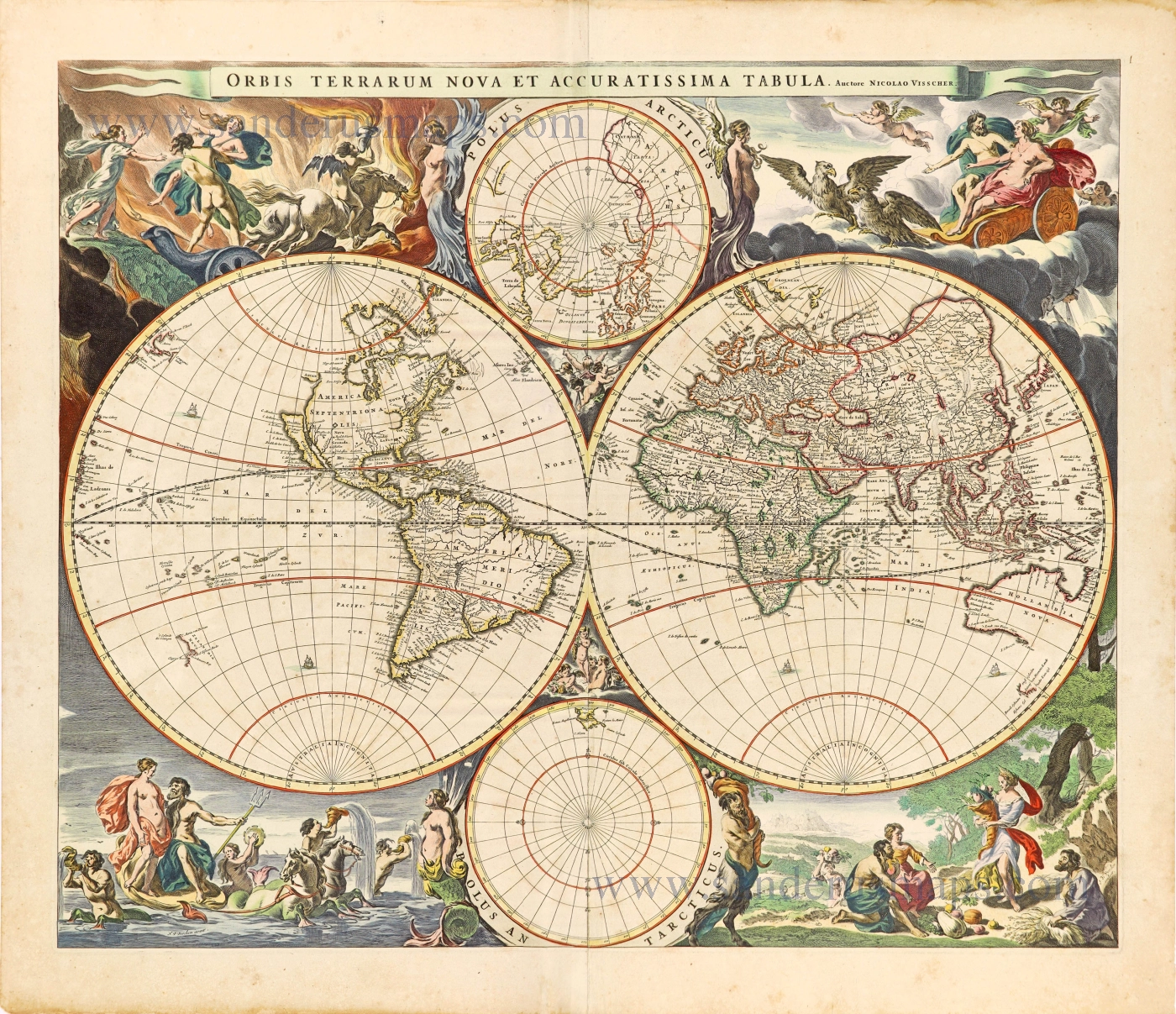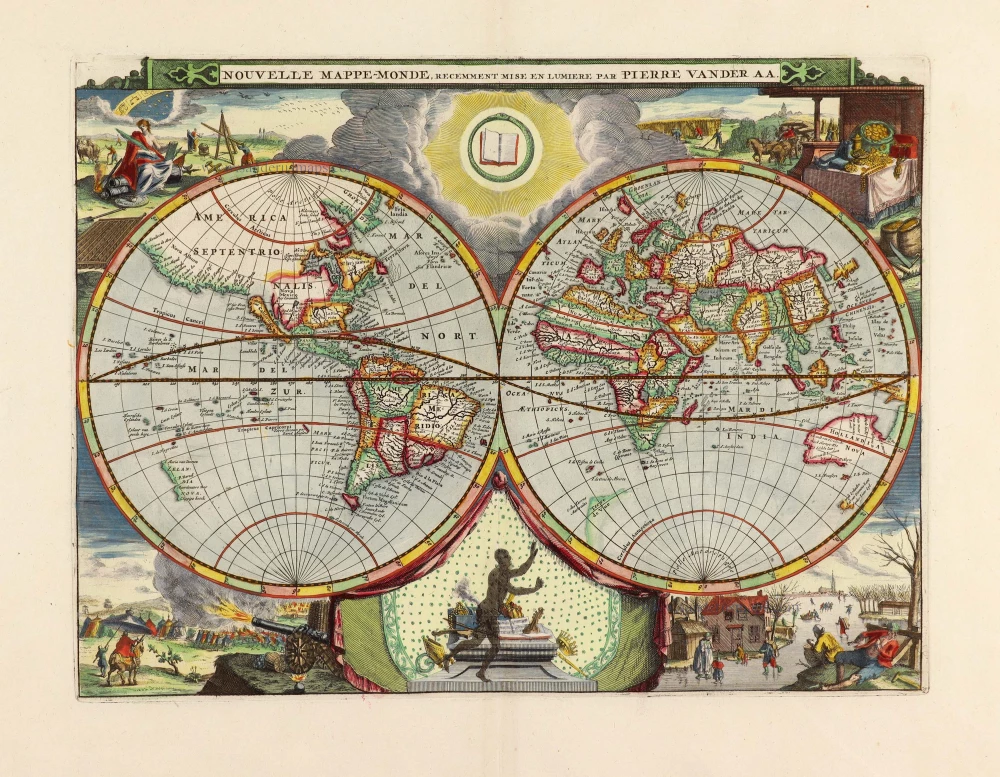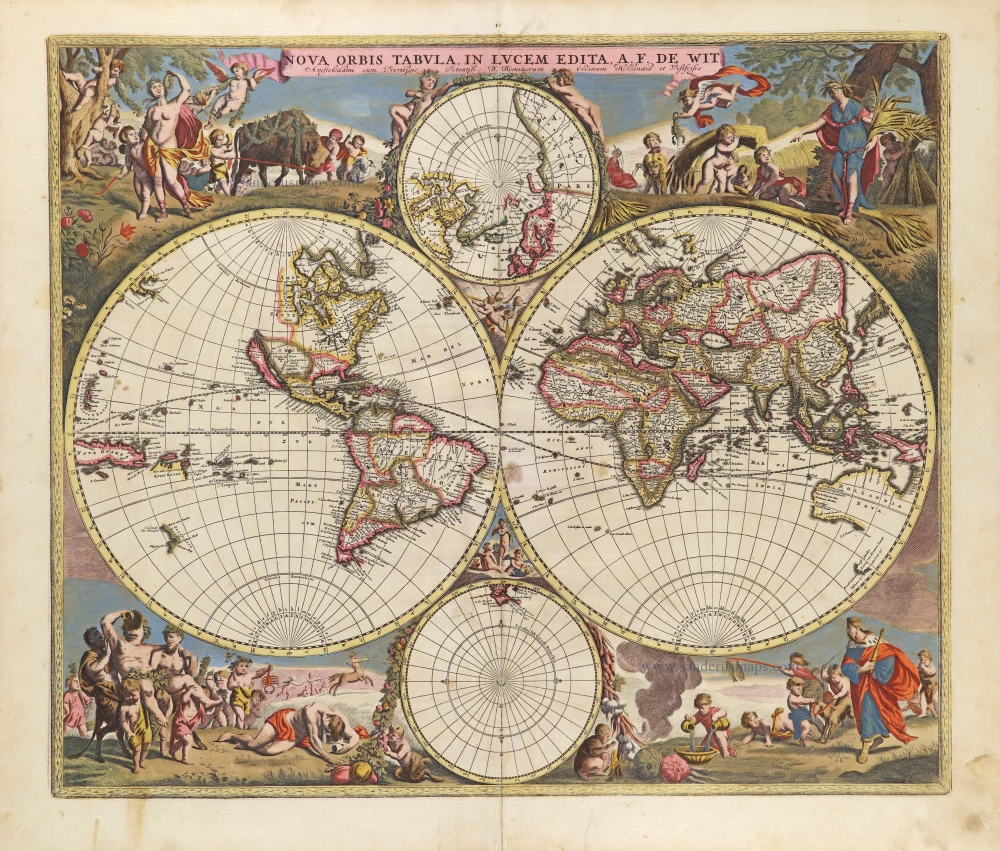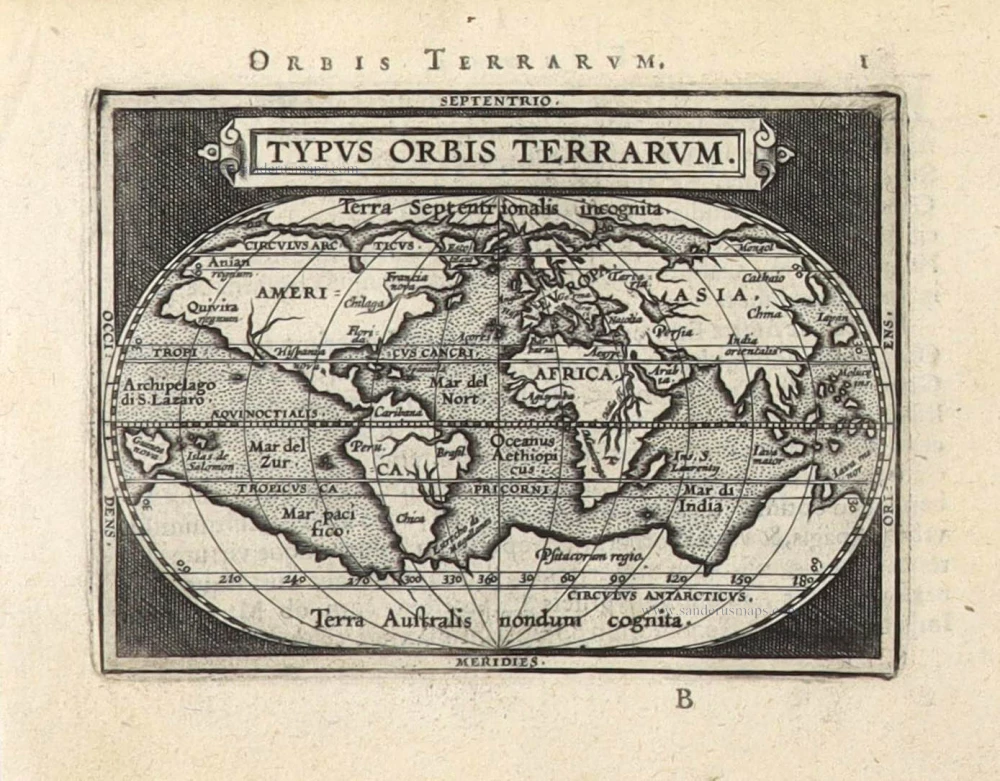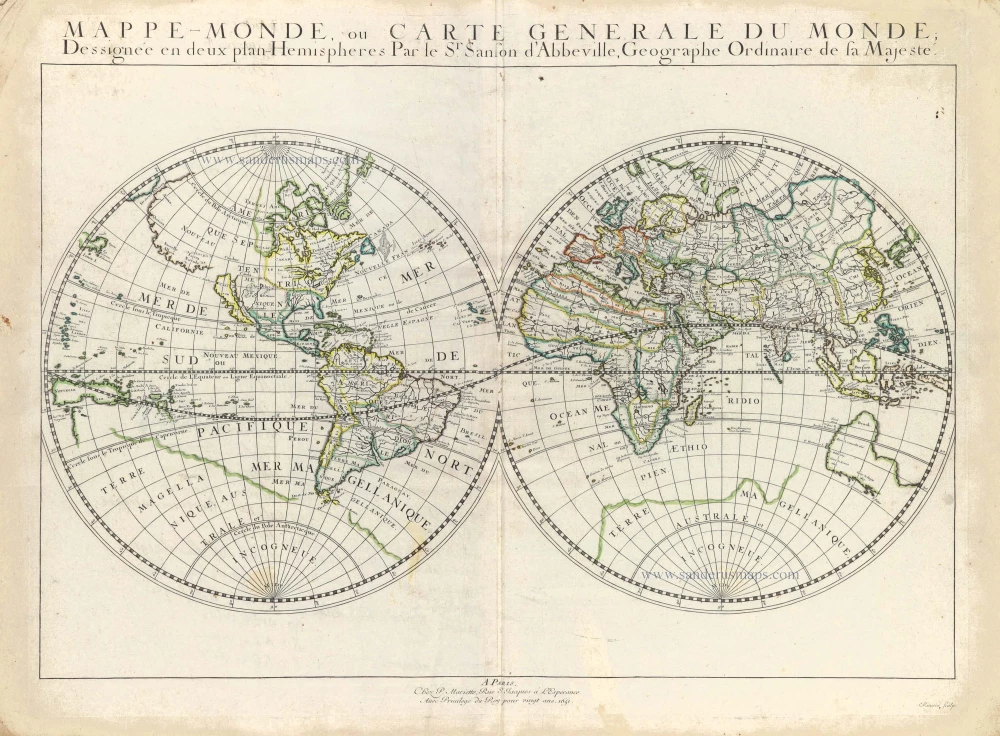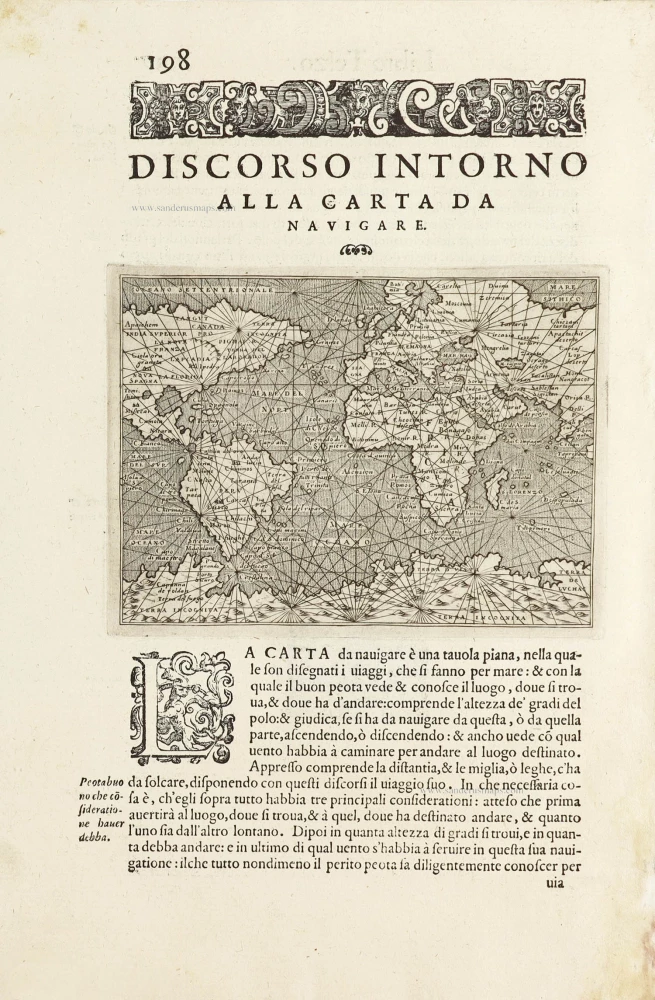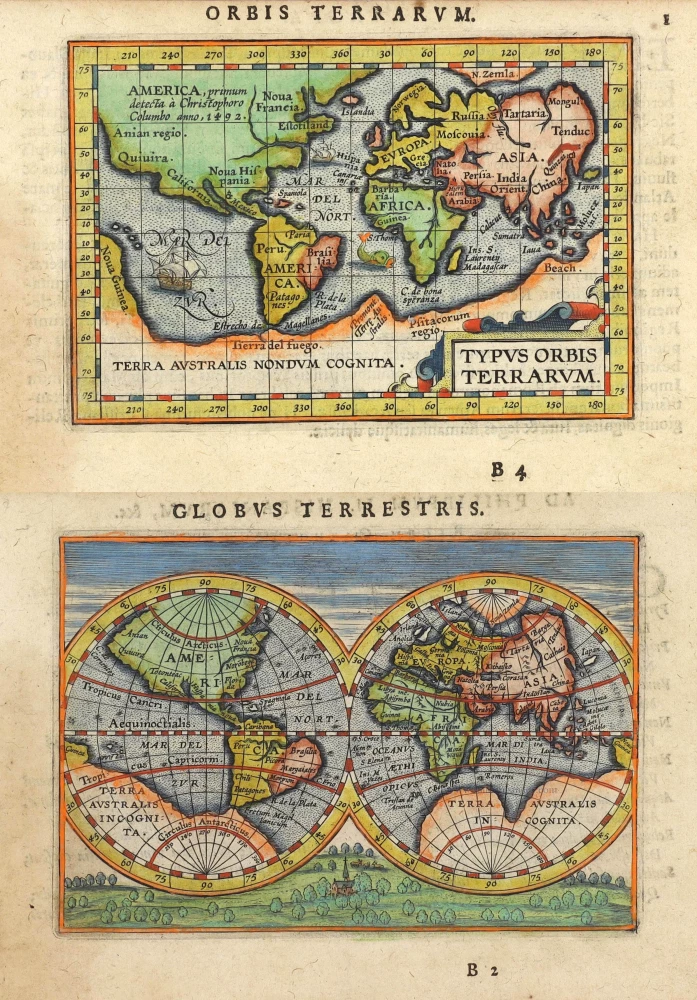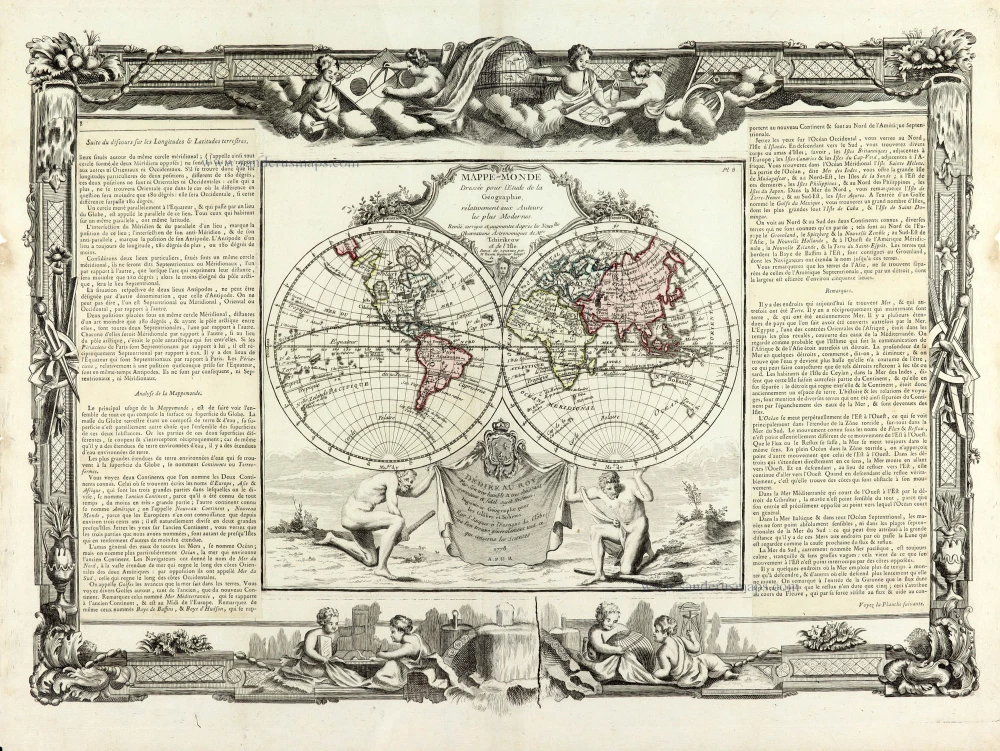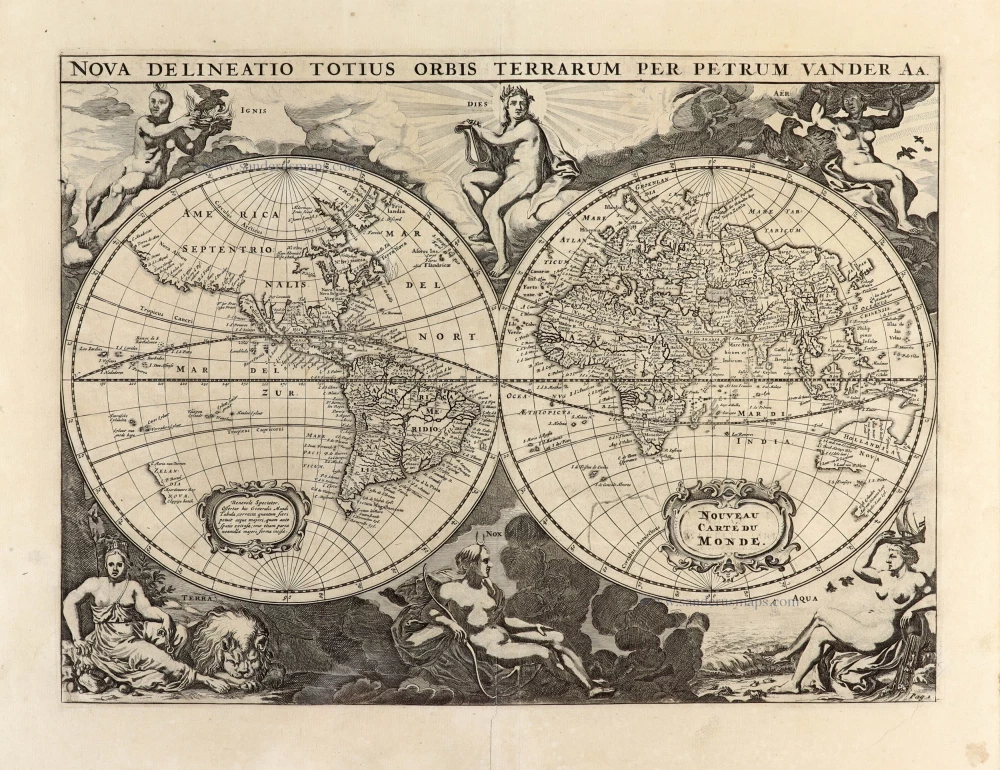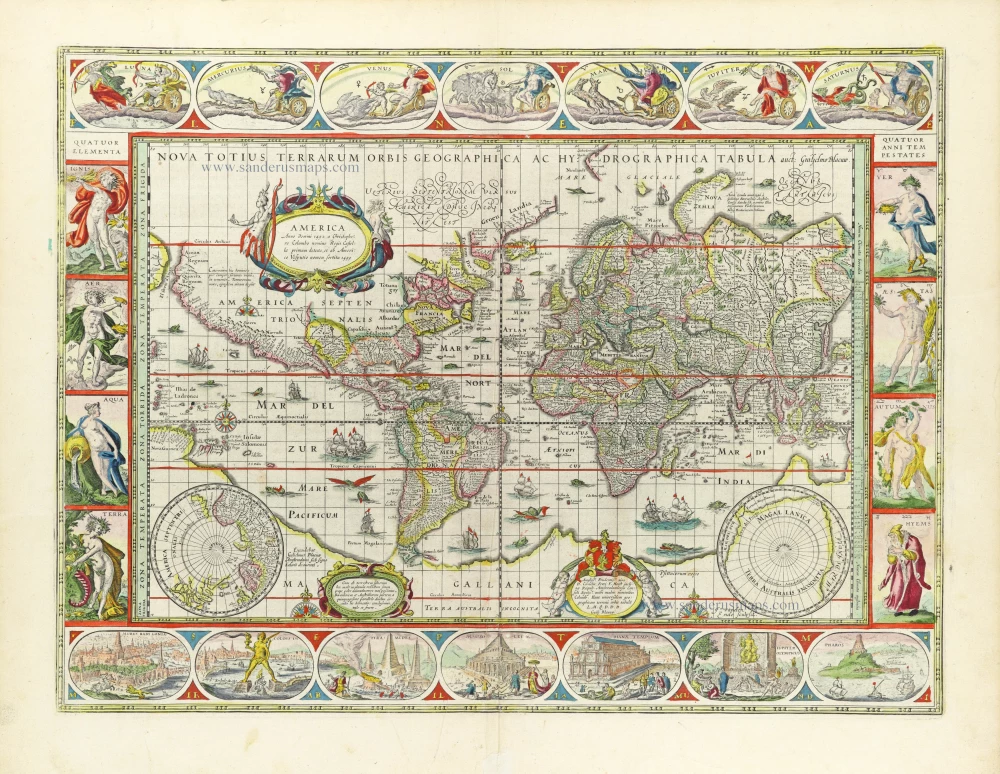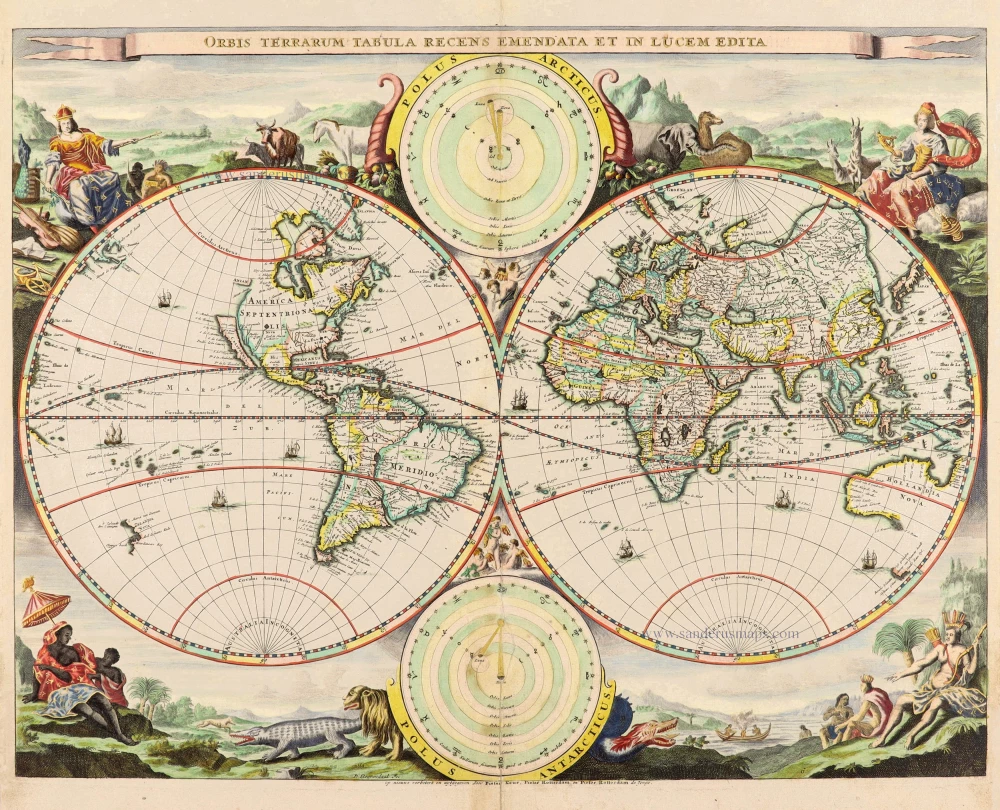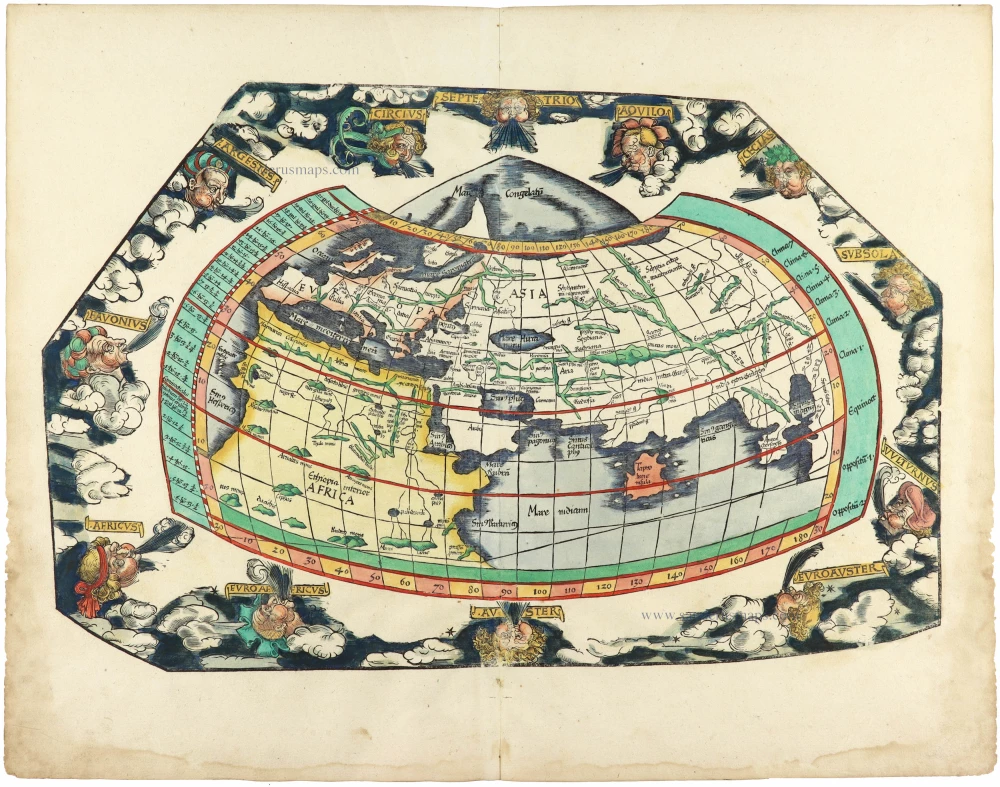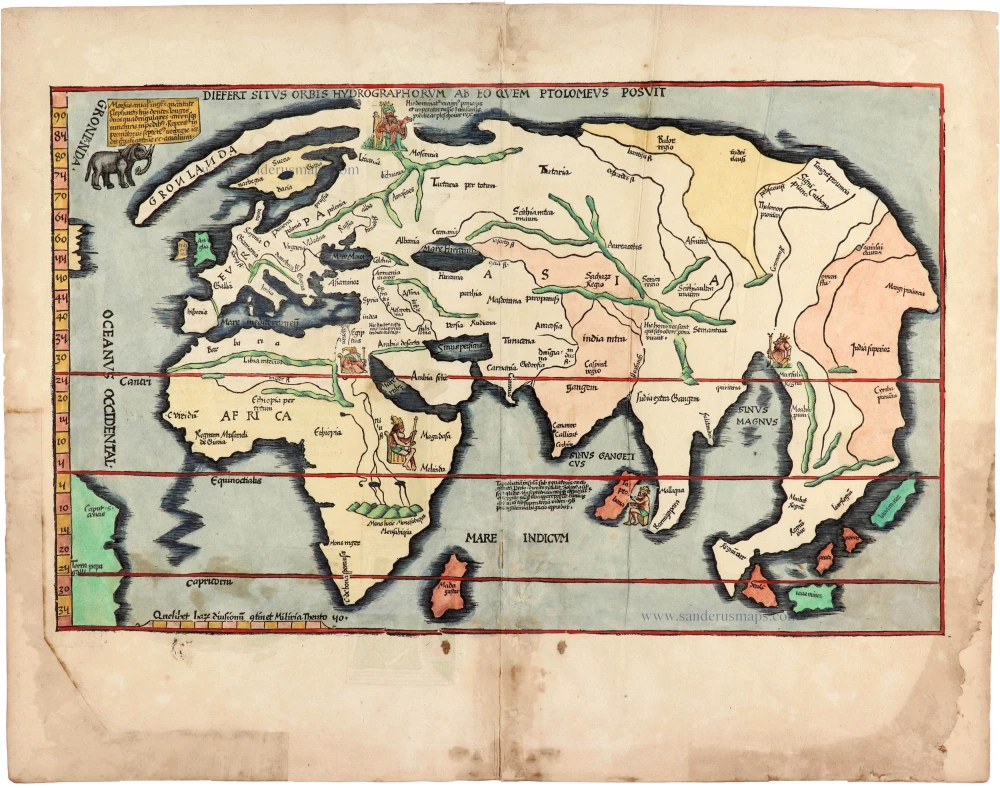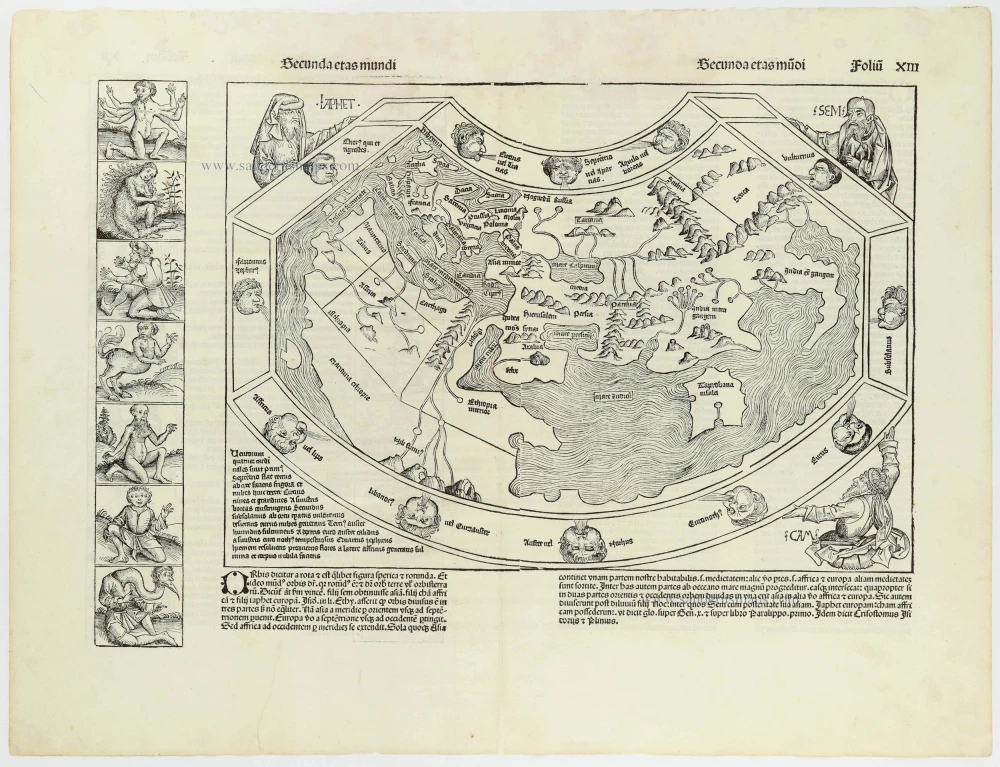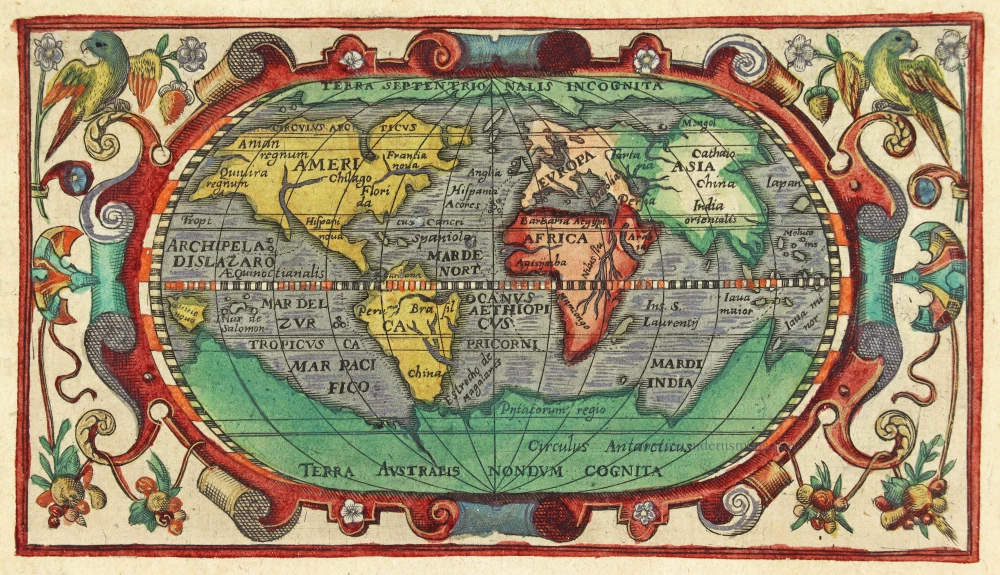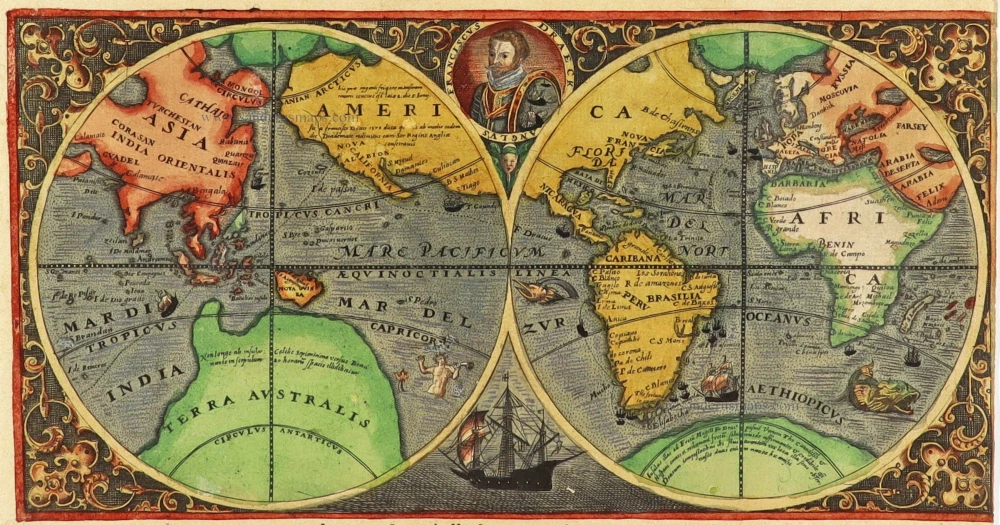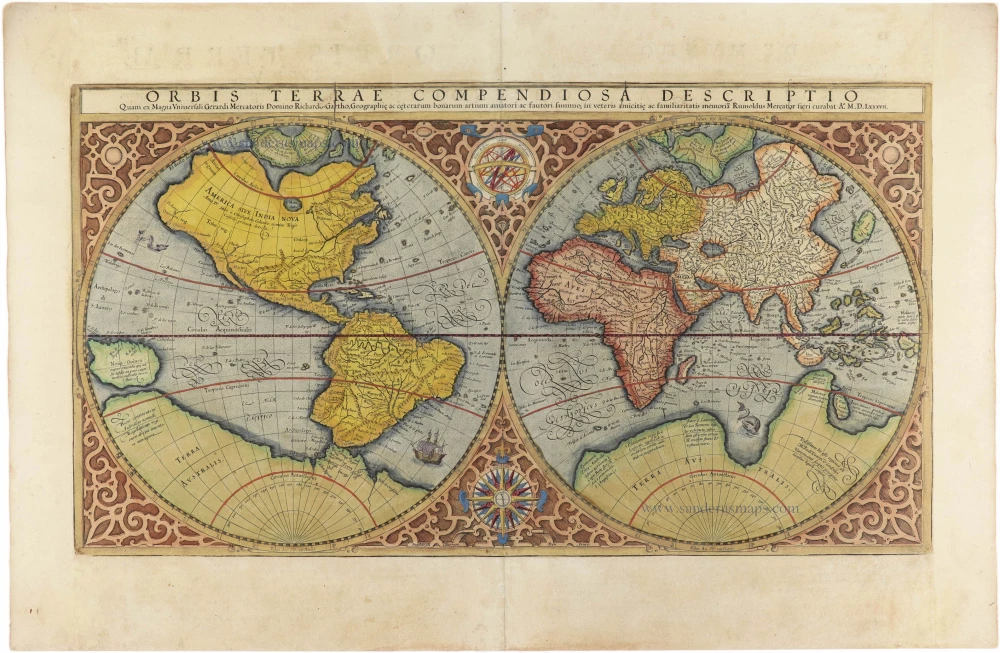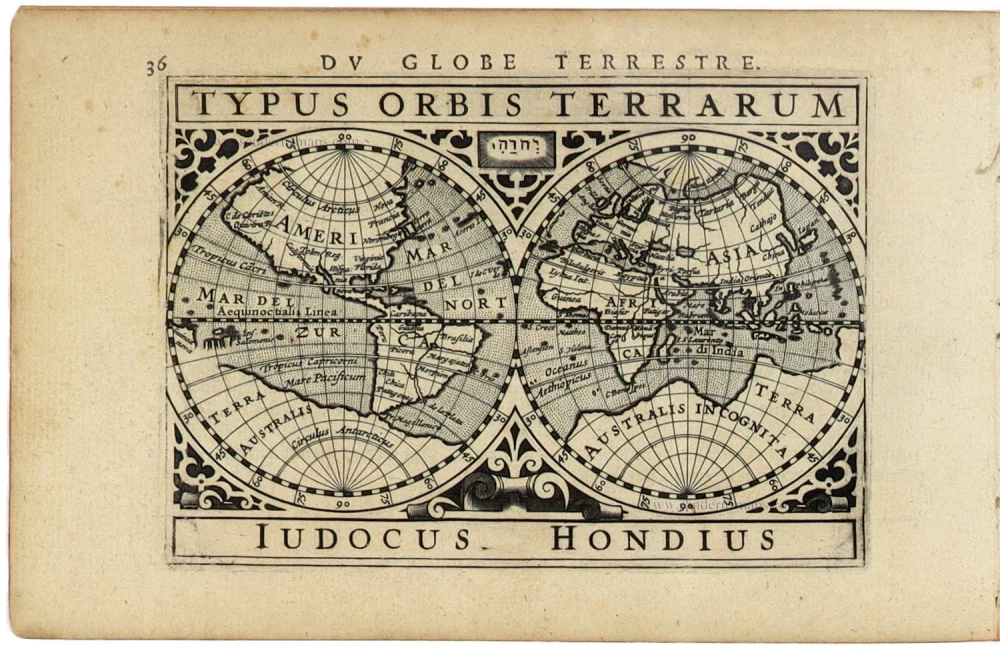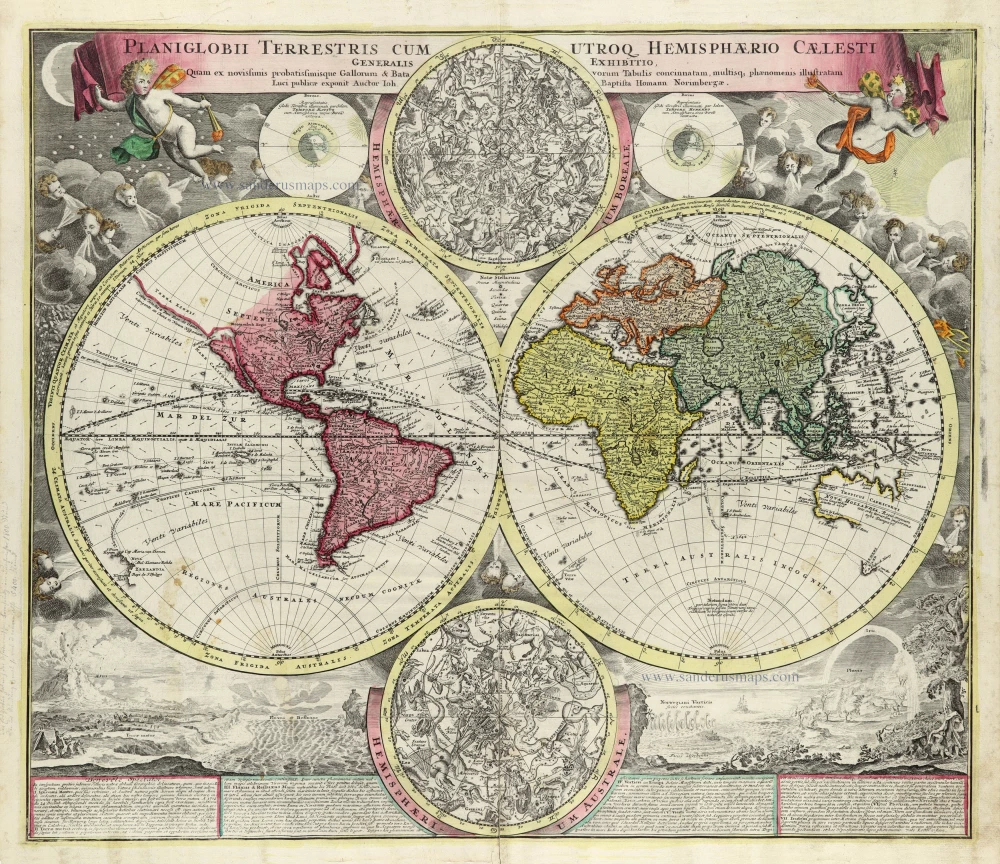Gottfried's first edition 1631
Willem C. Schouten, world map published by Gottfried. 1631
Above the map are two head-and-shoulder portraits of Ferdinand Magellan and Willem C. Schouten, each flanked by angels bearing laurel wreaths. The top corners contain portraits of four other circumnavigators: Francis Drake, Thomas Candish (Cavendish), Olivier van Noort and George van Spilbergen.
The map was copied from Schouten's map of 1618, which appeared in an account of a voyage round the world in 1615-17 under the sailing captainship of Willem Cornelis Schouten and commanded by Jacob Le Maire. During its circumnavigation, the expedition discovered a new strait off Tierra del Fuego named after Le Maire. They also charted Staten Island nearby and hitherto unknown stretches of the New Guinea coastline.
Theodore de Bry (1528 – 1598) and his family.
Theodore de Bry was born in 1528 in the Prince-Bishopric of Liège in the southern Netherlands (today Belgium). Trained as a goldsmith in his father's workshop, he left his home town around 1558 and moved to Strasbourg. Religious motives partly inspired his emigration, but commercial incentives were probably more critical for de Bry since Strasbourg was more attractive. Here, he gradually began to shift his focus to copper engraving. In the early 1560s, Theodore married Strasbourg-born Katharina Esslinger, and the couple went on to have four children together before Katharina died c. 1569. Johan Theodore (b. 1563) and Johan Israel (b. 1565) followed in their father's footsteps and took up his trade. He remarried in 1570 to Katharina Rölinger.
In 1577, after the Pacification of Gent had quietened religious tensions in the Netherlands, Theodore and his family moved to Antwerp. There, they lived close to the printing house of Christopher Plantin, and it was there that Theodore began making copper engravings. Copper engraving was a well-developed art in the Low Countries, and Antwerp artists were in great demand. In 1584, when Catholic troops besieged Antwerp, Theodore and his family moved to London, where he made copper engravings for an essential English navigation manual, The Mariners Mirrour. He also found the inspiration to produce the collection to which his name would forever be attached.
He met the artist Jacques Le Moyne de Morgues, a draughtsman who had been to Florida in the 1560s as part of a French expedition. He returned to Europe with watercolours of the natural world he had seen and the indigenous peoples. After Le Moyne's death, thanks to the mediation of Richard Hakluyt, Theodore acquired these drawings.
Hakluyt and de Bry began collaborating on a series of books about America. In 1588, the de Bry family moved to Frankfurt, where Theodore published the first volume of the America series. This first volume was the only one in the collection that appeared in four different languages: German, Latin, French and English. The following volumes appeared only in German and Latin. As a result, the relationship between de Bry and his English partners quickly soured.
Theodore continued publishing and produced a blend of richly illustrated prestigious volumes of the Voyages collection, the family firm's flagship publication.
Theodore de Bry died on March 27th, 1598. At this time, the highly successful and lucrative America series had already extended to seven volumes, and there would be fourteen. To these must be added the 'Elenchus', published in 1634 by Merian, which was a collective title and table of contents of these same volumes.
In 1597, the de Bry brothers published the first volume of the East India series. These were also published in folio but with slightly smaller page sizes than the America volumes. To distinguish the East India series from his America series, the two parallel sets subsequently became known among bibliophiles as de Bry’s Petits Voyages and his Grands Voyages, respectively.
The Petits Voyages consist of thirteen volumes, published between 1597 and 1633.
After Theodore de Bry's death, the business was run by his son, Johann Theodore and then by his grandson, Matthäus Merian and grandson-in-law, William Fitzer. Precisely what part de Bry's widow and his other son played in the business is unclear, but they certainly seemed to have retained some interest. After all, it must have become a very profitable venture for the whole family. Together, they continued to publish volumes of the Grands and Petits Voyages for another 46 years. The last volume, a third edition of Part IV of the America series, finally appeared in 1644.
Willem Cornelisz. Schouten (Hoorn, c. 1567 - 1625)
Dutch navigator for the V.O.C. (Verenigde Oostindische Compagnie - Dutch East India Company). He was the first to sail the Cape Horn route to the Pacific Ocean in an expedition led by Jacob le Maire and sponsored by Isaac Le Maire.
Although he had opened an unknown route (south of Cape Horn) for the Dutch, the VOC claimed infringement of its trade monopoly to the Spice Islands. Schouten was arrested (and later released), and his ship was confiscated in Java. On his return, he would sail again for the VOC, and on one of these trips, he died off the coast of Madagascar in 1625.
[no title]
Item Number: 31560 Authenticity Guarantee
Category: Antique maps > World and Polar
Double hemisphere world map by Willem C. Schouten, published by Theodor de Bry.
[no title]
Date: 1631
Copper engraving, printed on paper.
Image size: 170 x 205mm (6¾ x 8 inches).
Sheet size: 355 x 22mm (14 x ¾ inches).
Verso: Blank.
Condition: Excellent.
Condition Rating: A+.
From: GOTTFRIED J.L., Historia Antipodum oder Newe Welt . . Frankfurt am Main, Matthias Merian, 1631.
Above the map are two head-and-shoulder portraits of Ferdinand Magellan and Willem C. Schouten, each flanked by angels bearing laurel wreaths. The top corners contain portraits of four other circumnavigators: Francis Drake, Thomas Candish (Cavendish), Olivier van Noort and George van Spilbergen.
The map was copied from Schouten's map of 1618, which appeared in an account of a voyage round the world in 1615-17 under the sailing captainship of Willem Cornelis Schouten and commanded by Jacob Le Maire. During its circumnavigation, the expedition discovered a new strait off Tierra del Fuego named after Le Maire. They also charted Staten Island nearby and hitherto unknown stretches of the New Guinea coastline.
Theodore de Bry (1528 – 1598) and his family.
Theodore de Bry was born in 1528 in the Prince-Bishopric of Liège in the southern Netherlands (today Belgium). Trained as a goldsmith in his father's workshop, he left his home town around 1558 and moved to Strasbourg. Religious motives partly inspired his emigration, but commercial incentives were probably more critical for de Bry since Strasbourg was more attractive. Here, he gradually began to shift his focus to copper engraving. In the early 1560s, Theodore married Strasbourg-born Katharina Esslinger, and the couple went on to have four children together before Katharina died c. 1569. Johan Theodore (b. 1563) and Johan Israel (b. 1565) followed in their father's footsteps and took up his trade. He remarried in 1570 to Katharina Rölinger.
In 1577, after the Pacification of Gent had quietened religious tensions in the Netherlands, Theodore and his family moved to Antwerp. There, they lived close to the printing house of Christopher Plantin, and it was there that Theodore began making copper engravings. Copper engraving was a well-developed art in the Low Countries, and Antwerp artists were in great demand. In 1584, when Catholic troops besieged Antwerp, Theodore and his family moved to London, where he made copper engravings for an essential English navigation manual, The Mariners Mirrour. He also found the inspiration to produce the collection to which his name would forever be attached.
He met the artist Jacques Le Moyne de Morgues, a draughtsman who had been to Florida in the 1560s as part of a French expedition. He returned to Europe with watercolours of the natural world he had seen and the indigenous peoples. After Le Moyne's death, thanks to the mediation of Richard Hakluyt, Theodore acquired these drawings.
Hakluyt and de Bry began collaborating on a series of books about America. In 1588, the de Bry family moved to Frankfurt, where Theodore published the first volume of the America series. This first volume was the only one in the collection that appeared in four different languages: German, Latin, French and English. The following volumes appeared only in German and Latin. As a result, the relationship between de Bry and his English partners quickly soured.
Theodore continued publishing and produced a blend of richly illustrated prestigious volumes of the Voyages collection, the family firm's flagship publication.
Theodore de Bry died on March 27th, 1598. At this time, the highly successful and lucrative America series had already extended to seven volumes, and there would be fourteen. To these must be added the 'Elenchus', published in 1634 by Merian, which was a collective title and table of contents of these same volumes.
In 1597, the de Bry brothers published the first volume of the East India series. These were also published in folio but with slightly smaller page sizes than the America volumes. To distinguish the East India series from his America series, the two parallel sets subsequently became known among bibliophiles as de Bry’s Petits Voyages and his Grands Voyages, respectively.
The Petits Voyages consist of thirteen volumes, published between 1597 and 1633.
After Theodore de Bry's death, the business was run by his son, Johann Theodore and then by his grandson, Matthäus Merian and grandson-in-law, William Fitzer. Precisely what part de Bry's widow and his other son played in the business is unclear, but they certainly seemed to have retained some interest. After all, it must have become a very profitable venture for the whole family. Together, they continued to publish volumes of the Grands and Petits Voyages for another 46 years. The last volume, a third edition of Part IV of the America series, finally appeared in 1644.
Willem Cornelisz. Schouten (Hoorn, c. 1567 - 1625)
Dutch navigator for the V.O.C. (Verenigde Oostindische Compagnie - Dutch East India Company). He was the first to sail the Cape Horn route to the Pacific Ocean in an expedition led by Jacob le Maire and sponsored by Isaac Le Maire.
Although he had opened an unknown route (south of Cape Horn) for the Dutch, the VOC claimed infringement of its trade monopoly to the Spice Islands. Schouten was arrested (and later released), and his ship was confiscated in Java. On his return, he would sail again for the VOC, and on one of these trips, he died off the coast of Madagascar in 1625.


